The Government of Ancient Egypt
The government of Ancient Egypt depended on two important factors; the pharaoh and agriculture. The Pharaoh was a vital part of the the Egyptian government and he appointed the other officials during most periods. The highest officials took their orders directly from the king. Agriculture was the foundation of Egypt's economy and government.
Since the pharaoh was considered chosen by the gods, his power was nearly absolute. From his throne, he acted as an intermediary between the human and divine world. He was also considered a god himself, making him both divine and an absolute ruler. However, even an absolute, theocratic monarch could not run the government without help.
History of Ancient Egypt's Government
Before the Old Kingdom
Scholars have found few government records from before the Old Kingdom Period. Evidence shows that Egypt was a united kingdom with a single ruler, which indicates that the first pharaohs must have set up a form of central government and established an economic system.
Before the Persian Period, the Egyptian economy was a barter system and not monetary. People paid taxes to the government in the form of crops, livestock, jewelry or precious stones. In return, the government maintained peace in the land, saved food in case of famine and conducted public works.
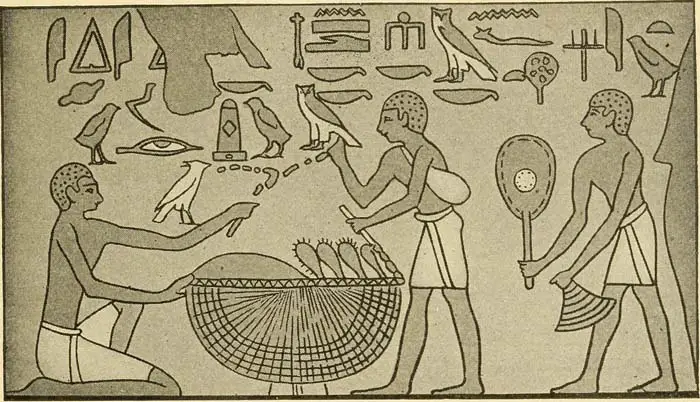
© Internet Archive Book Images - Barter trade system
The Old Kingdom
Ancient Egypt's government became more centralized during the Old Kingdom. King Narmer united the country around 3150 BC, leading to Egypt's first centralized government, built around the king. Building large stone pyramids meant the pharaoh had to make changes to the government. Pharaohs from Dynasties Three and Four maintained a strong central government and they had almost absolute power.
Earlier pharaohs created a strong government that allowed them to summon large work forces. They appointed their high officials, and they chose members of their family. These men were loyal to the pharaoh. The government then let the pharaoh gather and distribute enough food to support huge numbers of workers, which allowed them to build large stone pyramids.It was during the Third Dynasty that the first massive gathering of workers and artisans took place. The result was the great Step Pyramid of Djoser (built sometime between between 2667 and 2648 BC).
During the Old Kingdom period, a hierarchy was established that lasted through the Old, Middle, and New Kingdom periods. At the top was the king or pharaoh. Just beneath him was the vizier, who had powers similar to the king but was ultimately answerable to the royal throne. Beneath the vizier were the royal treasurer and chief scribes. All of these were based in a central area (in the case of the Old Kingdom, Memphis).
Followed by these were the regional heads, the nomarchs. Below them were the individual city mayors. Underneath the mayors were other sets of regional scribes. Then there were the individual overseers of work projects, who were often answerable to the central government. Beneath them were the abundant farmers, small landholders, and artisans who contributed to the food and infrastructure of Egypt. Finally, beneath all these were the peasant and slave classes, who were usually the most numerous of all. There may have been more or fewer intermediaries within the government structure, depending on the location and type of undertaking.
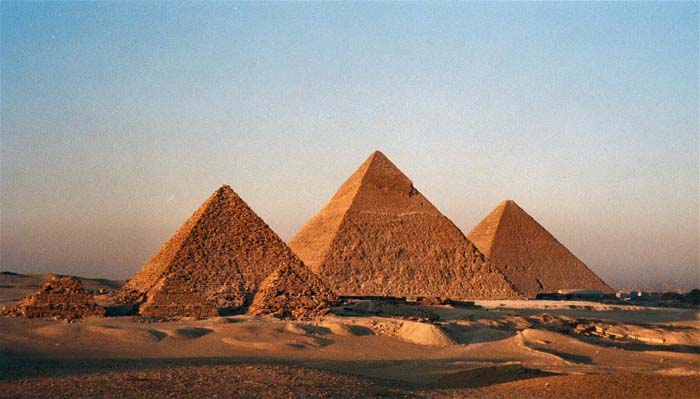
© Bruno Girin - The famous pyramids at Giza
During Dynasties Five and Six, the pharaoh's power lessened. Government positions had become hereditary and the district governors, called nomarchs, grew powerful. By the end of the Old Kingdom, nomarchs were ruling their nomes (districts) without the oversight of the pharaoh. When the pharaohs lost control of the nomes, the central government collapsed. Modern scholars divide Egyptian history into Kingdom Periods and Intermediate Periods. In the Kingdom Periods, the government was strong and usually centralized. When the government had collapsed or was in disarray, it is referred to as an Intermediate Period. Keep in mind, these are modern distinctions, and the Egyptians did not divide their history into periods as far as we know.
The Intermediate Periods
Modern scholars place three Intermediate Periods into the timeline of Ancient Egypt's history. The Old, Middle and New Kingdoms were each followed by an intermediate periods. All three of these had unique characteristics, but they have two common features. Each represents a time when Egypt was not unified, and there was no centralized government. During the first Intermediate Period, for example, the substantially weakened kings moved the capital from Memphis the Herakleopolis. From there, it would be moved again to the newly powerful city of Thebes at the beginning of the Middle Kingdom. It is theorized that, during the Intermediate Periods, the nomarchs were often more powerful and effective than the king himself.
The Middle Kingdom
The Old Kingdom's government served as a base for the Middle Kingdom's. The pharaoh made changes, including the addition of more officials. Titles and duties were more specific which limited each official's sphere of influence.
While the foundations of the government were the same, what distinguished the Middle Kingdom from the Old Kingdom was that each administrative center in the central government was duplicated. This was so that both the Upper Kingdom and the Lower Kingdom were represented equally. It also accounts for some of the unique architecture of the time, which included facilities with two entrances and palaces with two throne rooms. Even when Egypt was very much united, the Egyptians never forgot that they once came from two separate states.
The central government became more involved in the nomes and had more control of individual people and what they paid in taxes. The pharaoh tried to limit the power of the nomarchs. He appointed officials to oversee their activity and he weakened the nomes by making towns the basic unit of the government. The mayors of individual towns became powerful.
The increase in government officials led to the growth of the middle-class bureaucracy.
Officials based taxes on an assessment of cultivable land and the flooding of the Nile. During periods of low flooding, officials reduced taxes, while the government levied a poll tax on each citizen, which they paid in produce or craft goods.
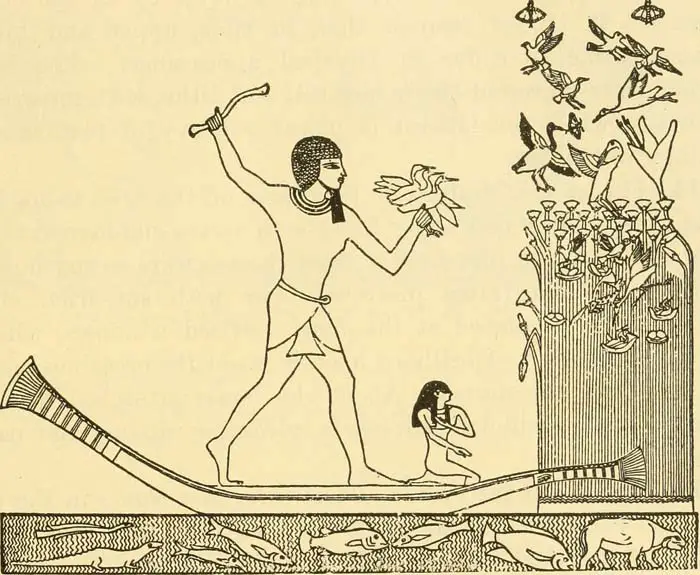
© Internet Archive Book Images - People paid taxes in produce
The New Kingdom
The New Kingdom is the most well documented period when it comes to the structure and actions of the government. The Second Intermediate Period had seen the loss of the Lower Kingdom to a people called the Hyksos, while the Upper Kingdom was under constant threat by the Kushites, who took back much of their land that had been conquered by Egypt.
It was the pharaoh Ahmose I who finally drove the Hyksos out of Lower Egypt and reunified the kingdoms. This marked the end of the Second Intermediate Period and the beginning of the New Kingdom.
The pharaohs of the New Kingdom continued to build their government on the foundations of earlier governments. One change they made was a decrease in the land area of nomes and an increase in their number. During this period, the pharaohs created a standing army and created military positions. Before this, the pharaohs formed armies using conscripted people.
The 19th Dynasty saw the beginning of a break-up in the legal system. Before this dynasty, government appointed judges made decisions based on evidence presented to them. During this period, however, people began obtaining verdicts from oracles. Priests read a list of suspects to the state god's image, and the statue indicated the guilty party. This change represented an increase in the priesthood's political power. It was open to corruption.
After the New Kingdom
During the Late Period, the pharaohs reunited Egypt and centralized the government. When Persia conquered Egypt, the new rulers established a monetary economy. The Persian monarchs made Egypt a satrapy, and appointed a governor to rule. The regional administrative system was kept in place. The Greek and Roman Empires later imposed their governmental systems on Egypt, also keeping some aspects of Egypt's regional government.
Shemsu Hor Starting in the Old Kingdom, a custom was introduced called the Shemsu Hor (Following of Horus). This helped to ensure money and taxes were allocated properly and that no one could embezzle or exploit the system. During this event, the king and a large retinue of advisors, overseers, ad scribes would travel throughout the country, making the king's power apparent to all. Their purpose was to oversee things such as tax collection, the building of public works, construction of tombs, and the effectiveness of the courts. The convention was introduced right after Narmer's reign.
The Shemsu Hor had many components. It was a means of collecting taxes. It was a way in which the people of Egypt could see the king's power up close. It was a way the king could begin and oversee the organization of new building projects. And, in later times, it became a means of taking an accurate census. It also defrayed the cost of having all things in the royal court, centralizing power but decentralizing the need to travel and gain approval from a central bureaucracy. Eventually, even civil and criminal trials were conducted through the Shemsu Hor. It allowed the pharaoh to oversee regional projects personally.
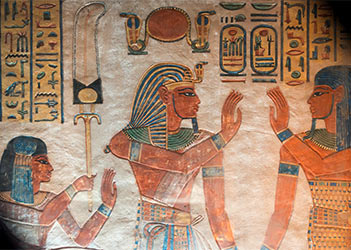
© Kairoinfo4u
Ancient Egypt Government Officials
Egypt had many different government officials. Some operated at national level, while others were regional.
The vizier was the most important person after the pharaoh. Each pharaoh appointed his/her vizier, who oversaw the judiciary system and the government administration. The vizier sat in the high court, which handled serious legal cases, often involving capital punishment. Egypt usually had one vizier; sometimes there were two, who oversaw either Upper or Lower Egypt.
Another important position was the chief treasurer. He was responsible for collecting and assessing taxes. The treasurer also monitored the redistribution of the items brought in through taxes. He had other officials under his command, who helped collect taxes and keep tax records.
Some periods also had a general. He was responsible for organizing and training the army. Either the general or the pharaoh led the army into battle. Sometimes, the crown prince served as the general before ascending to the throne.
Overseer was a common title in the Ancient Egyptian government. They managed work sites, like the pyramids, and some also watched over granaries and monitored their contents.
Scribes formed the basis of the Egyptian government. They wrote official documents and could move to higher positions.
Ancient Egypt Government Documents
A lot of the information scholars have about Egypt's government comes from tomb inscriptions. Government officials either built their own tombs or the pharaoh gave them one. Their tombs included inscriptions detailing their titles and some events from their lives. As an example, one official's tomb had a description of a time he greeted a foreign trade embassy for the pharaoh.
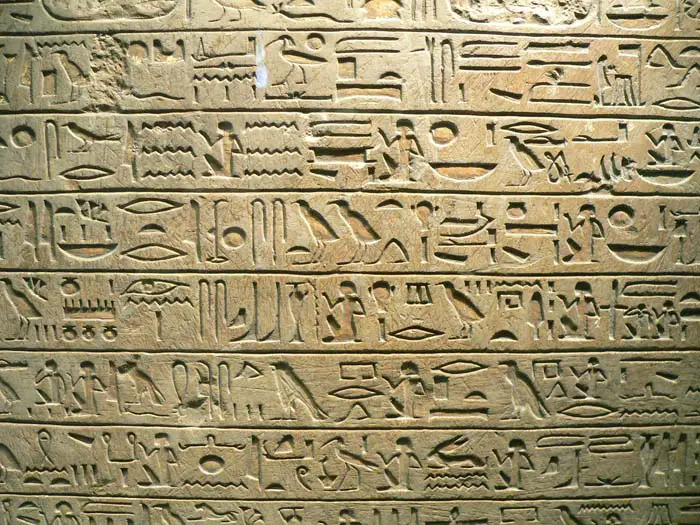
© Clio20 - Stela of Minnakht, chief of scribes
During the New Kingdom, some pharaohs gave their officials tombs, which helps identify those who served specific pharaohs. They also reveal changes in the government's high officials. Many pharaohs appointed officials from the bureaucracy, and some appointed men who had served in the military.
Scholars have also found law documents, including detailed cases of tomb raiders. They mention the steps the government took to punish them and try to prevent further raiding.
High officials sealed documents detailing property transfers. They maintained control of any property that was brought into a marriage, even if there was a divorce. Both men and women could file for divorce, though it was easier for a man to obtain it. In the event of a divorce, the man had to compensate the woman and the government insured the people followed these rules.
Government in Thebes
Egypt's central government moved when the pharaoh changed his/her capital. The central officials worked out of the royal compound. Thebes served as a government and religious capital for centuries.
When Thebes was Egypt's capital, the mayor of Thebes held a position of power.
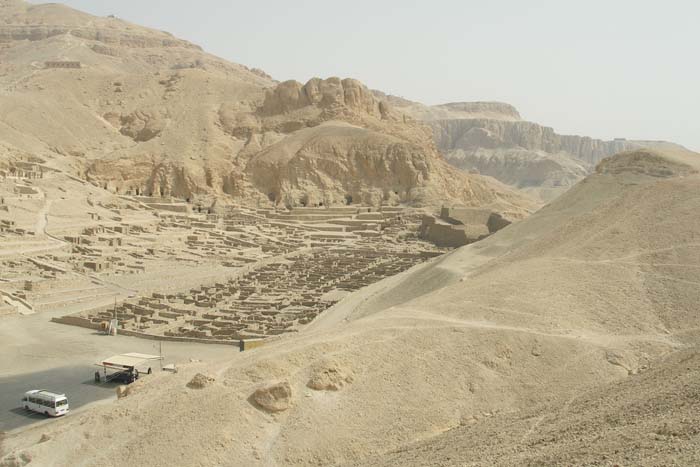
© Vyacheslav Argenberg - Thebes
Certain high officials were buried in the Valley of the Kings, yielding a few significant aspects, such as the position they held and whom they served. Moreover, there are mentions of honors granted by the pharaoh, who certainly valued the official, given that he was granted a tomb in the royal cemetery.
The pharaoh sometimes had a funerary temple built for one of his officials in the Theban Necropolis. They also granted favored officials land revenues to provide goods for their funerary cult.
Ancient Egypt Government Facts
- The pharaoh was the ultimate authority in Ancient Egypt.
- The vizier was the most powerful government official.
- Viziers were second only to the pharaoh in power.
- Egypt was divided into nomes, and a nomarch governed each one.
- People paid taxes with agriculture produce or precious materials.
- The government stored food and distributed it to workers or to the people in times of famine.
- The government ran building projects, like the pyramids.
Bibliography
- An Introduction to the Archaeology of Ancient Egypt. London: Blackwell Publishing, 2008.
- Ancient Egypt: Anatomy of a Civilization. Second Edition. New York: Routledge, 2006.

